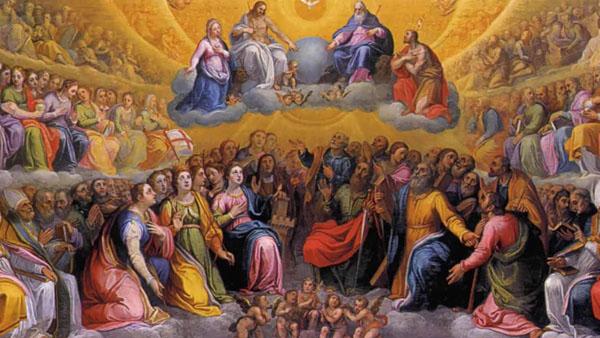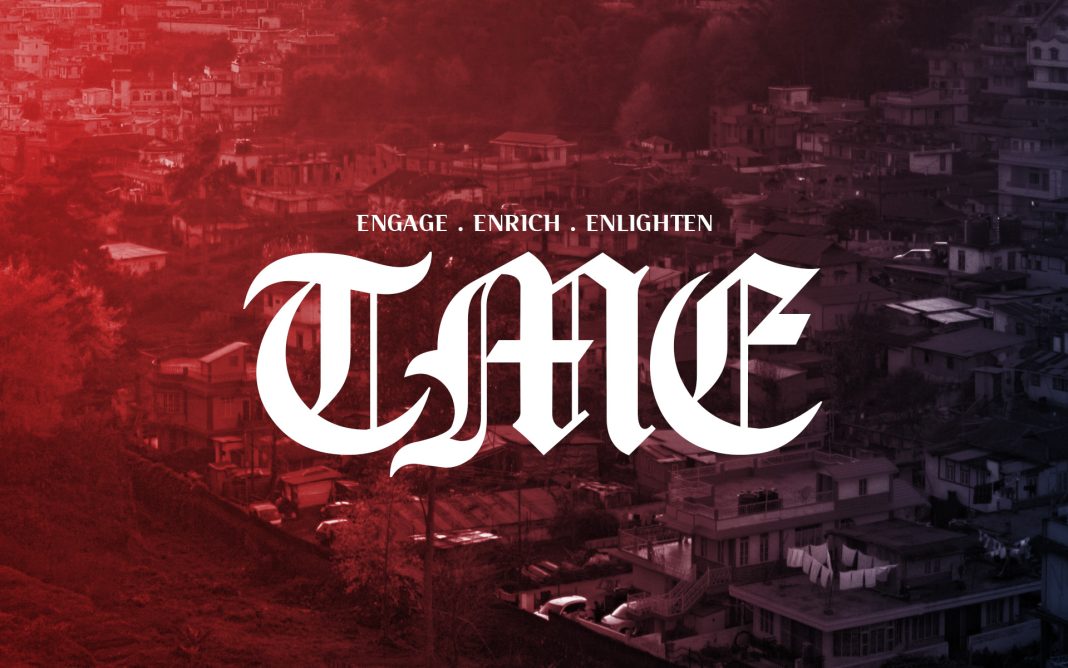By Dipak Kurmi
All Saints’ Day, known by various names such as All Hallows’ Day, the Feast of All Saints, Hallowmas, and the Solemnity of All Saints, stands as one of Christianity’s most profound solemnities, honouring the saints—both known and unknown—who have attained the beatific vision in heaven. This sacred day serves as a reminder of the unity between the living, the dead, and those in eternal glory, encapsulating the spiritual communion that binds the Church together across time and eternity.
Origins and Early Development
The roots of All Saints’ Day can be traced back to the early centuries of Christianity when believers sought to commemorate the martyrs who had given their lives for their faith. As early as the 4th century, various Christian communities held feast days dedicated to all martyrs. These commemorations were not uniform: they were observed near Easter in some regions, while others celebrated them near Pentecost. For example, the Church in Edessa celebrated a feast for all martyrs on May 13, while the Syrians observed it on the Friday after Easter, and Antioch on the Sunday following Pentecost.
In the 5th century, St. Maximus of Turin delivered annual homilies in honour of all martyrs on the Sunday after Pentecost. Similarly, the Comes of Würzburg, a lectionary dating to the late 6th or early 7th century in what is now Germany, lists a “Sunday of the Nativity of the Saints” for the same period. This evolution reflected an expanding sense of sanctity that encompassed not just martyrs but all holy individuals who had lived righteous lives.
A pivotal moment came on May 13, 609 or 610, when Pope Boniface IV consecrated the Pantheon in Rome to the Blessed Virgin Mary and all martyrs. This act marked the formal establishment of a collective feast known as the Dedicatio Sanctae Mariae ad Martyres. Some scholars suggest that the date was chosen to coincide with the ancient Roman festival of Lemuria, a pagan observance in which Romans appeased the restless spirits of the dead. The adaptation of this date by the Church symbolised Christianity’s transformation of older customs into sacred expressions of faith.
The Shift to November 1st
The celebration on November 1 emerged later, with the influence of both theological development and cultural adaptation. Pope Gregory III (731–741) dedicated an oratory in St. Peter’s Basilica to “the holy apostles and all saints, martyrs, confessors, and all the just made perfect throughout the world.” Some accounts suggest that Gregory III dedicated this oratory on November 1, thereby fixing the date of the feast. Other historians, however, propose that he held a synod on November 1, 731, while dedicating the oratory months later, on Palm Sunday of 732.
By the 9th century, churches in the British Isles were already celebrating All Saints on November 1, a practice that spread rapidly throughout Europe. The Irish Martyrology of Tallaght and the Martyrology of Óengus from this period commemorate all saints of the world on this date. Influential figures such as Alcuin of Northumbria, a scholar at the court of Charlemagne, promoted the observance throughout the Frankish Empire.
In 835, Emperor Louis the Pious, Charlemagne’s son, officially declared November 1 a holy day of obligation throughout the empire, doing so at the request of Pope Gregory IV. This decree gave universal recognition to the feast, transforming it into one of the most significant celebrations in the Christian calendar.
Theological Meaning and Liturgical Context
All Saints’ Day is more than a commemoration; it is a theological affirmation of the mystical unity of the Church. In Catholic doctrine, it embodies the communion of saints—an unbroken bond between the “Church triumphant” (those in heaven), the “Church militant” (the living faithful), and the “Church penitent” (souls in purgatory). The following day, All Souls’ Day, commemorates the faithful departed, emphasizing prayer and remembrance for those who have not yet reached the fullness of salvation.
In the Western liturgical calendar, the celebration begins with First Vespers on the evening of October 31—All Hallows’ Eve, commonly known today as Halloween—and concludes with Compline on November 1. The three-day period from October 31 to November 2, known as Allhallowtide, encapsulates a spiritual cycle of remembrance, intercession, and hope.
The Catholic Church regards All Saints’ Day as a Holy Day of Obligation*, requiring the faithful to attend Mass. The festival celebrates the triumph of sanctity and the eternal glory of those who have attained heaven. The Lutheran and Anglican traditions retain similar observances, though with distinct theological nuances. Lutherans mark it as a festival of gratitude for those who have “died in the Lord” and now rest in peace, awaiting the resurrection. In Methodist theology, it is a day of thanksgiving for the lives of all believers, “famous or obscure,” who have borne witness to faith and holiness.
The Spread of Observance and Regional Traditions
By the medieval period, All Saints’ Day had spread across Christendom, and local customs flourished in every region. In 1471, Pope Sixtus IV extended the celebration into an octave, though this was later suppressed in the mid-20th century under the liturgical reforms of Pope Pius XII.
In the Roman Catholic world, All Saints’ Day remains a solemn and public expression of remembrance. Families attend Mass and visit cemeteries, adorning graves with flowers and candles. The flicker of candlelight across graveyards in the evening has become one of the most evocative symbols of the day—a representation of faith’s enduring flame that bridges the living and the dead.
In Protestant countries, particularly among Lutherans and Anglicans, All Saints’ Day also serves as a remembrance of the faithful departed. Churches often read the names of members who have died during the past year, accompanied by the tolling of bells or the lighting of candles. In the Church of England, it is one of the Principal Feasts of the year, celebrated either on November 1 or the following Sunday.
Global Observances and Cultural Expressions
Around the world, All Saints’ Day has taken on unique cultural forms while maintaining its sacred essence. In Austria and Germany, it is a “silent day” (stiller Tag), marked by solemnity and the gifting of Allerheiligenstriezel, a braided yeast pastry, from godparents to godchildren. In France, La Toussaint is a public holiday when families place chrysanthemums on graves, symbolising the beauty of remembrance and the transience of life. In Belgium, Toussaint is similarly observed with visits to cemeteries, and in Croatia, candles illuminate graveyards during Svi sveti, turning cemeteries into serene seas of light.
In Poland, Dzień Wszystkich Świętych is a deeply emotional public holiday when families gather to honour both saints and departed loved ones. Candles and flowers transform cemeteries into vast memorials of faith and continuity. Hungary’s Mindenszentek napja follows a similar pattern, with candlelight vigils and prayers, while Portugal’s Dia de Todos os Santos combines remembrance with the cheerful custom of Pão-por-Deus, in which children go door to door receiving cakes and sweets—a tradition that predates modern trick-or-treating.
In Spain, El Día de Todos los Santos is a national holiday marked by family visits to cemeteries and performances of José Zorrilla’s play Don Juan Tenorio, which explores redemption and the afterlife. In Switzerland, 15 cantons treat the day as a public holiday, celebrated with church services and the baking of traditional breads such as Allerheiligenzopf and Seelenzopf.
Across the Atlantic, Guatemala celebrates All Saints’ Day with vibrant colour and creativity. Families prepare fiambre, a rich salad of meats and vegetables, and share it with the spirits of the dead. In towns like Santiago Sacatepéquez, enormous hand-crafted kites are flown to symbolically unite the living with their ancestors. Mexico, meanwhile, merges All Saints’ Day with Día de los Muertos, commemorating deceased children on November 1 (Día de los Inocentes) and adults on November 2.
In the Philippines, the three-day observance known as Undás or Todos los Santos combines Catholic devotion with indigenous tradition. Families travel to ancestral cemeteries to clean and decorate tombs, offer prayers, light candles, and share food. The atmosphere is both reverent and festive, turning cemeteries into places of reunion. The custom echoes pre-colonial Filipino practices such as pangangaluluwa, where groups would visit homes singing songs for the souls of the departed—a spiritual forerunner of Halloween carolling.
The Eastern Christian Perspective
In the Eastern Orthodox and Eastern Catholic Churches, All Saints’ Day is not observed on November 1 but rather on the first Sunday after Pentecost. This timing reflects the belief that the descent of the Holy Spirit sanctifies all believers, uniting them in holiness. The observance, known as All Saints’ Sunday (Ἁγίων Πάντων), is documented as early as the 4th century in the homilies of St. John Chrysostom. Emperor Leo VI of Byzantium (866–911) greatly enhanced its prominence when he dedicated a church to All Saints in honour of his devout wife, Empress Theophano.
The East Syriac and Chaldean traditions commemorate All Saints on the first Friday after Easter, aligning with their theology of resurrection. The Coptic Orthodox Church celebrates All Saints on Nayrouz, September 11, marking the start of the Coptic New Year. This diversity of observance across Christendom underscores the universality of the feast’s message—eternal life and unity in faith.
Modern-Day Observance and Public Recognition
All Saints’ Day remains a public holiday in numerous countries including France, Italy, Spain, Portugal, Austria, Poland, Hungary, the Philippines, and much of Latin America. In India, it is a recognised Christian observance and a public holiday in the state of Karnataka. Its coincidence with state foundation days—such as Karnataka Rajyotsava, Kerala Foundation Day, and others—adds a unique civic resonance to the date.
In Western nations, October 31, the vigil of All Saints’ Day, evolved into Halloween, derived from All Hallows’ Eve. Historically a Christian evening of prayer and fasting, it has become largely secularised, though its spiritual roots persist in traditions like lighting candles for the departed. In Anglican, Lutheran, and Reformed traditions, All Hallows’ Eve also coincides with Reformation Day, commemorating Martin Luther’s nailing of the Ninety-Five Theses in 1517.
The Enduring Meaning of All Saints’ Day
At its heart, All Saints’ Day transcends denominations, geography, and time. It is a festival of memory and hope, affirming that the journey of faith continues beyond the bounds of mortality. The lighting of candles, the offering of flowers, and the recitation of prayers across the world echo a shared human longing—to remember, to honour, and to believe in the communion of life eternal.
As church bells toll and hymns like “For All the Saints” and “Ye Watchers and Ye Holy Ones” fill sanctuaries, believers are reminded that sanctity is not reserved for a select few but is a universal calling. Every act of faith, love, and sacrifice brings humanity closer to the divine. The saints, both known and unknown, stand not as distant figures but as companions on the journey of salvation.
Through centuries of transformation—from the Roman Pantheon to modern cemeteries adorned with light—All Saints’ Day remains a radiant testament to the unbroken bond between heaven and earth. It is, in essence, the eternal communion of souls, celebrating not only those who have reached the glory of God but also the enduring hope of all who walk in faith.
(the writer can be reached at dipakkurmiglpltd@gmail.com)




